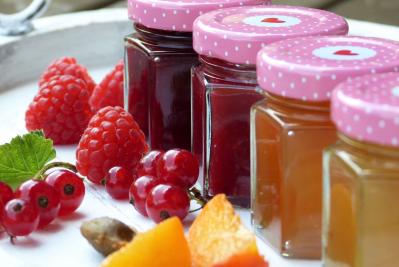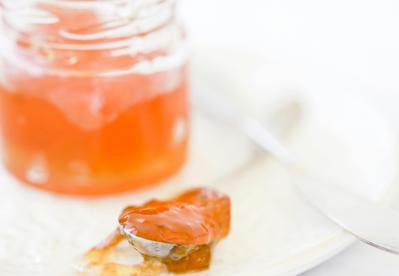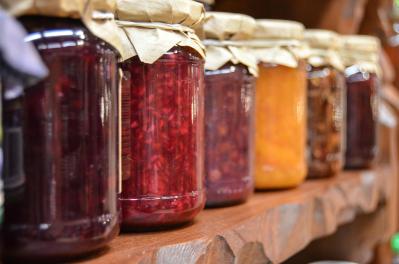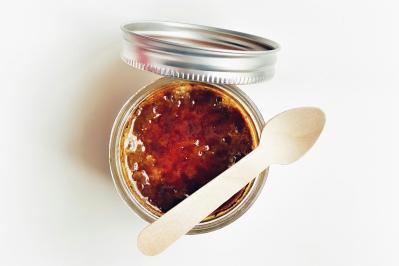
Analysis of
marmalade and jam
Marmalades, jams and jellies are popular spreads that are made by cooking pureed or chopped fruit and sugar. When differentiating between jams, marmalades and jellies, the type of fruit, the sugar content and the method of preparation all play a role.
In the European Union, the term “marmalade” may only be used for products made from citrus fruits such as lemons, oranges and mandarins in accordance with the Marmalade Ordinance. All other types of fruit are referred to as jams. An exception is made for sales at local weekly markets or farmers' markets, as jams made from strawberries or currants may also be sold there, even if they are not citrus fruits.
Unlike jams and marmalades, which are made from boiled fruit, jellies are usually only made from fruit juice, sugar and gelling agents and do not normally contain any pieces of fruit.
The composition of jams and marmalades is precisely regulated by law. Depending on the type of fruit, a minimum fruit content is prescribed, and no colorants or flavorings may be added. For the additional designation “Extra”, the product must have a higher fruit content.
Challenges for producers and distributors of marmalade and jam
The production and distribution of jams and marmalades is complex and is influenced by numerous factors. The main challenges for distributors of jams and preserves are
- Strict legal requirements (e.g. regulations on designation, nutritional labeling, product quality)
- Varying consumer preferences (e.g. increasing health awareness, desire for variety)
- Strong competition (established brands with a high level of recognition and low-priced own brands from discounters are competing for market share)
- Other economic factors (e.g. rising energy prices and personnel costs)
When developing new jams and marmalades, a good balance must be struck between flavor profile and consistency, while adhering to the specifications for the product class in terms of fruit and sugar content.
Fruit pieces enrich the appearance and taste of jams, but also pose a challenge during production. For example, discoloration or sedimentation can occur during the preserving process.

Necessary tests for the analysis of marmalade and jam
Residue Analysis
Pesticides
Pesticides can enter the marmalade or jam via the fruit used, which can later be detected in the end products.
Using a pesticide combination method, the accredited laboratories of the Tentamus Group offer the possibility of testing samples of marmalades and jams for over 800 pesticides.
Heavy metals
Residues of heavy metals can get into the marmalade or jam through contaminated soil or air pollution. Contamination can also occur during the processing of marmalade and jam if appliances or pipes are used that release heavy metals such as copper, lead or zinc (e.g. old copper kettles or pipes).
Residue analysis in the laboratory can detect such residues of heavy metals such as lead and cadmium.
MOSH/MOAH
Saturated and aromatic mineral oil hydrocarbons (MOSH or MOAH, Mineral Oil Saturated/Aromatic Hydrocarbons) are complex mixtures that can occur as contaminants in food and can usually enter the product via the packaging.
Our laboratories use special analytical methods such as gas chromatography and mass spectrometry to detect MOSH/MOAH residues in marmalade and jam samples.
Chemical analysis
Chemical analysis is used to determine the pH value and the Brix value. The Brix value is a measure of the sugar content of an aqueous solution and is an important parameter for quality control in the production of marmalades and jams.
Chemical analyses provide information on the content of total sulphurous acid, L-malic acid, sorbic acid and benzoic acid, which may be used as preservatives in regulated quantities. Their use must be indicated on the product label.
Microbiological contamination
Despite their high sugar content, marmalades and jams can, under certain conditions, be contaminated by microorganisms that affect the quality and safety of the products. In the Tentamus Group laboratories, samples can be tested for the following spoilage organisms:
- Yeasts and molds
- Osmophilic yeasts
- Enterobacteriaceae
- Total aerobic and anaerobic bacterial count
Sensory testing
Sensory tests are an indispensable part of quality assurance and product development for fruit spreads such as marmalades, jams and jellies. They serve to evaluate the properties of the fruit spread with the human senses and thus obtain a comprehensive picture of its quality. Taste, smell, mouthfeel, consistency and color play a decisive role here.
Constant monitoring of the fruit spreads through sensory tests quickly and reliably reveals changes in taste, smell and consistency and guarantees consistent product quality.
Labeling test
The labeling of marmalade and jam ensures that consumers receive all the information they need to make an informed purchasing decision. The labeling must comply with the applicable food law regulations and includes information such as
- Product name
- List of ingredients
- Net quantity
- Nutritional information
- Best before date
- Additives
- Allergens
As a service, the Tentamus Group offers comprehensive labeling tests in accordance with national and international standards.

Sample shipment for the analysis of marmalade and jam
To ensure that your marmalade or jam is analyzed quickly and reliably, the Tentamus Group offers you various options for sending samples:
- Shipment by parcel service
- Personal delivery to one of our laboratories
- Pick-up service within Germany

Relevant legal bases and directives
food@tentamus.com
+49 30 206 038 230
Overview of the Tentamus Group laboratories offering analyses of marmalade and jam
The following laboratories from the Tentamus Group offer the analyses:
This could also be of interest to you:
- Analyses
Residue analysis
Microbiological analysis
Chemical analysis
Sensory testing
- Product category
Dried Fruits
Fruits and vegetables
- Other Services